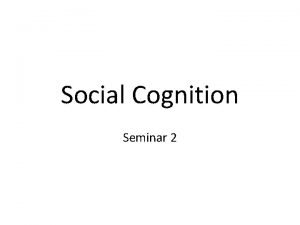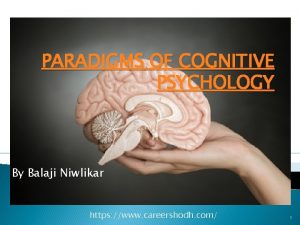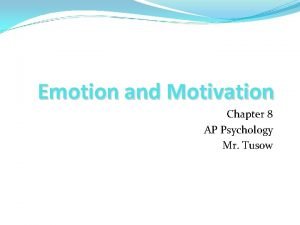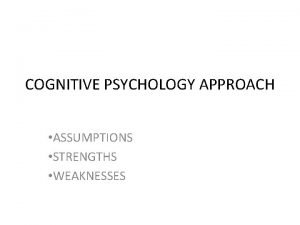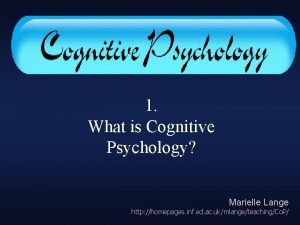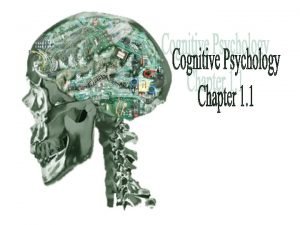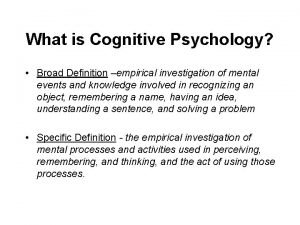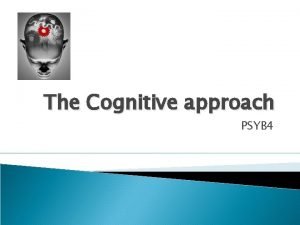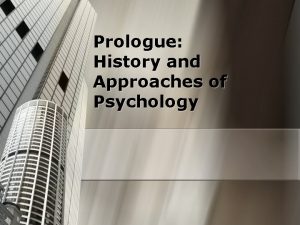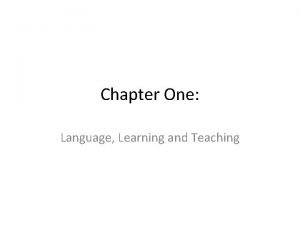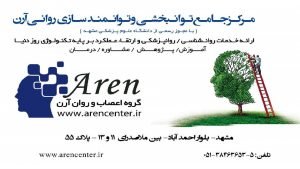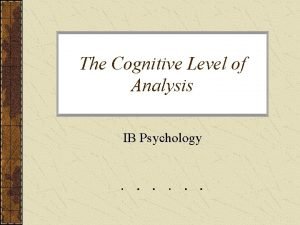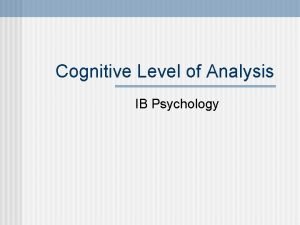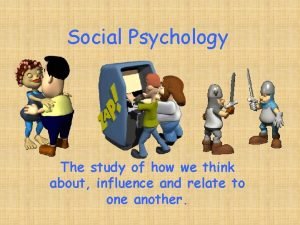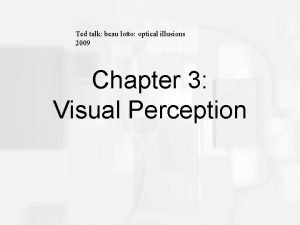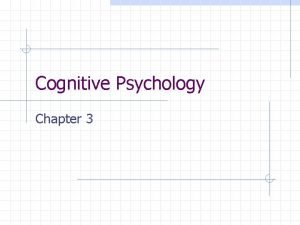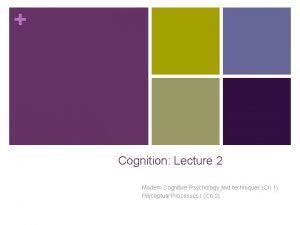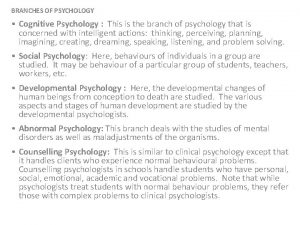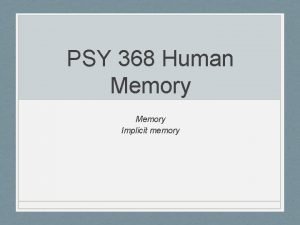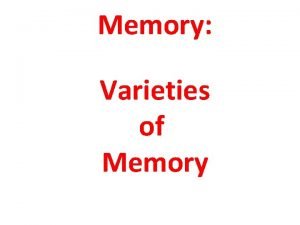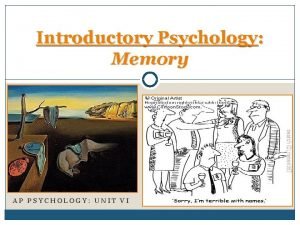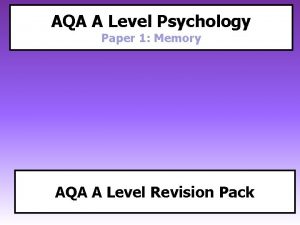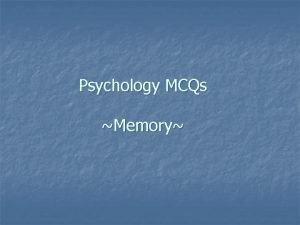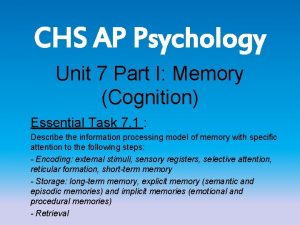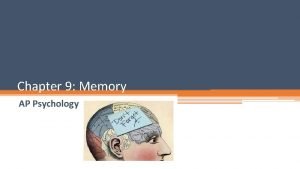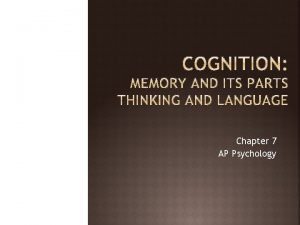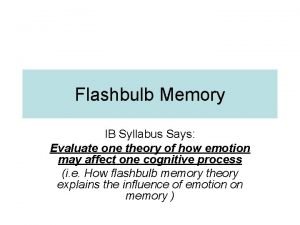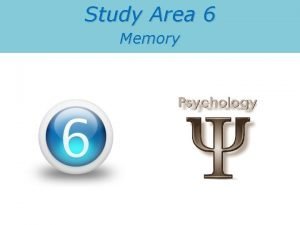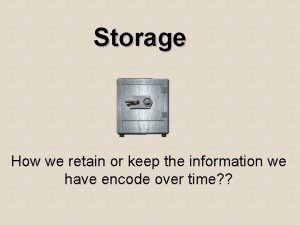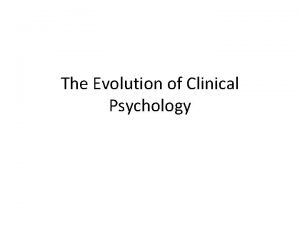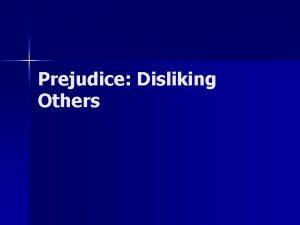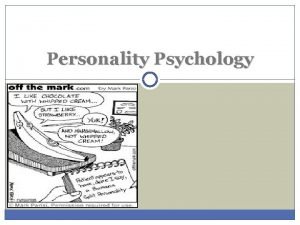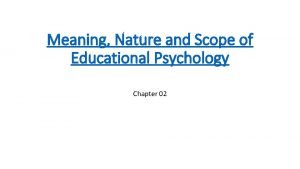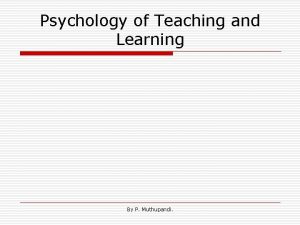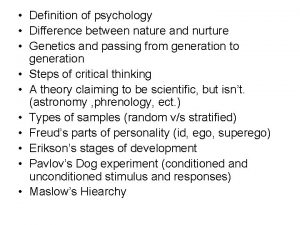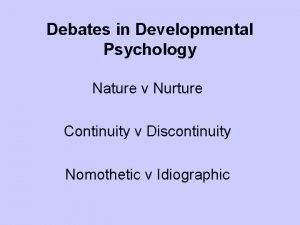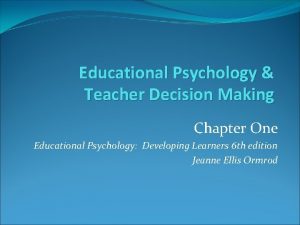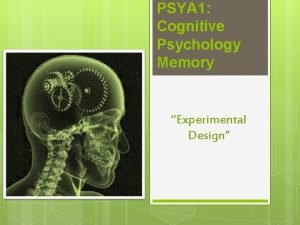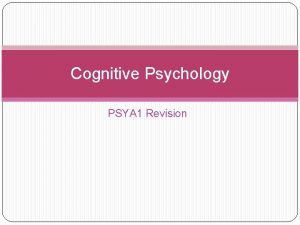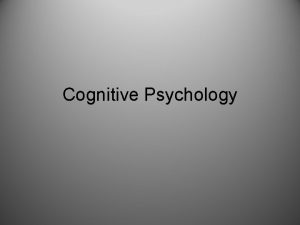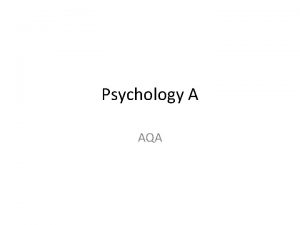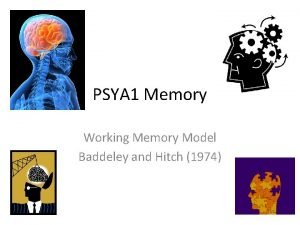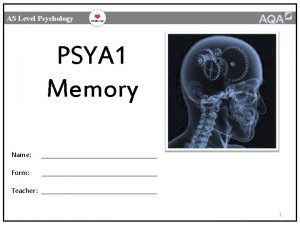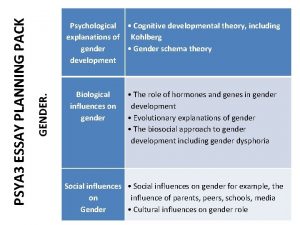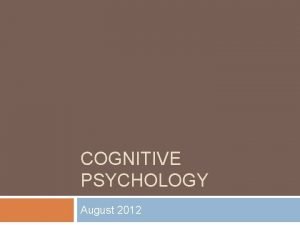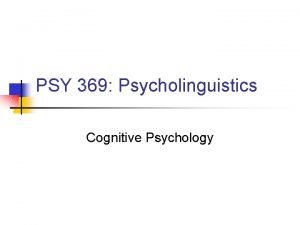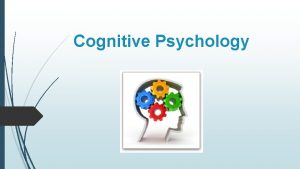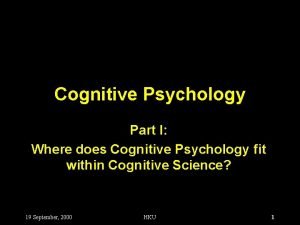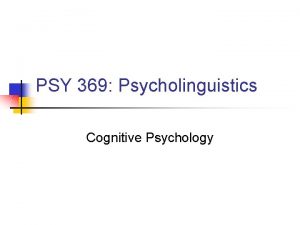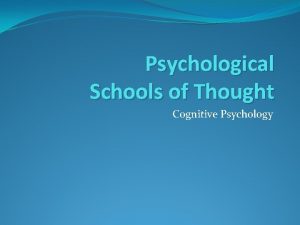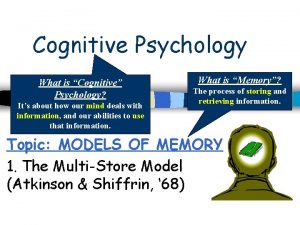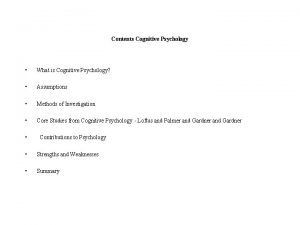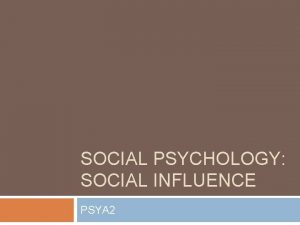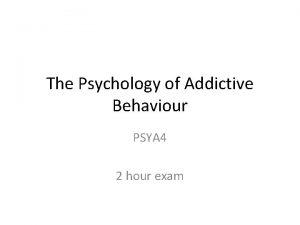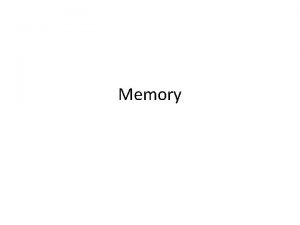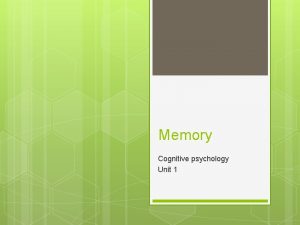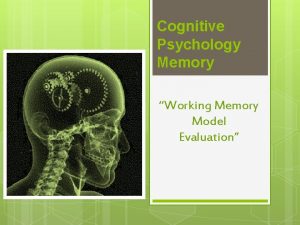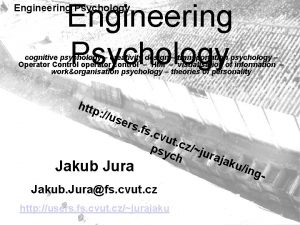PSYA 1 Cognitive Psychology Memory The Nature of
































































- Slides: 64

PSYA 1: Cognitive Psychology Memory The Nature of Memory Experimental Methods (Lab, Field, Natural) Mrs Leach

The Specification

PSYA 1 Memory What is A 01 and A 02? What is AO 1 and AO 2? Let’s apply this to a Donut… A 02 A 01 Application & Evaluation Knowledge & Understanding What is your opinion of the Donut? What are it’s strengths? What are it’s weaknesses? How does it compare to other cakes? What evidence is there for and against this Donut? Describe the Donut…. What is a Donut? What shape is it? What is it covered in? What ingredients does it contain? These questions are designed for you to demonstrate your knowledge and understanding of what a Donut is. You can do this in an exam by describing or outlining studies or theories. By doing this you are showing you know and understand! 3 These questions are designed to develop your evaluation and critical thinking skills. You can do this in the exam by evaluating theories using strengths and weaknesses. You can also present research evidence to support or refute.

To Start. . Imagine and discuss… You wake up one morning and you’ve lost your memory. Try to answer the following questions: 1. What do you normally do in a day that you would no longer be able to do? 2. What if you did not recognise your friends or family? 3. What experiences would you miss if you couldn’t remember TV programmes or news articles? 4. How could you plan your day if you forgot what you were thinking about a few minutes earlier?

How will I know if I am learning? 1. Describe STM in terms of capacity, encoding and duration (AO 1) 2. Describe LTM in terms of capacity, encoding and duration (AO 1) 3. To provide evidence in the form of studies for each description. (AO 2) 4. To explain what a lab experiment is and give advantages and disadvantages (AO 3)

What is Memory? Types of Memory Rehearsal Sensory Memory Encoding Short Term Memory Encoding Retrieval Long Term Memory

What is Memory?

What is Memory? Evidence for STM and LTM Now or Later? The “Recency/Primacy” Effect (Murdock 1962) Based on Murdock 1962 study. Laboratory experiment. presented participants with a list of words, one at a time, which they then recalled in any order (free recall). Your teacher is going to read you a list of 20 words, your job is to remember as many of the words as possible, as soon as your teacher has finished reading them write them down straight away (silently, don’t discuss or talk)

What is Memory? The “Primacy/Recency” effect You are now going to analyse the results. Your teacher will count up which words the class could remember. Position Word 1 st CAT 2 nd APPLE 3 rd BALL 4 th TREE 5 th SQUARE 6 th HEAD 7 th HOUSE 8 th DOOR 9 th BOX 10 th CAR 11 th KING 12 th HAMMER 13 th MILK 14 th FISH 15 BOOK 16 TAPE 17 th ARROW 18 th FLOWER 19 th KEY 20 th SHOE Number of people in class that remembered it!

Now or Later? The “Recency/Primacy” Effect Now plot your results on a graph: the X-axis will be word position and the Y-axis will be % recall. Do you see a pattern? Does is look anything at all like this figure? : Now you are going to analyze the results of your memory study.

What is Memory? You should have found that words read first and words read last are remembered better than words read in the middle! WHY? Can you explain why this is in terms of short term and long term memory? ?

What is Memory? Now or Later? The “Recency/Primacy” Effect Explanation: This experiment provides evidence that there are 2 types of memory (short term & long term). It is thought that memory is good for the words read last because they are still in short term memory (because you have just heard them) - this is the Recency effect. And memory is good for the words read first because they made it into long term memory - this is the Primacy effect.

Research Methods Link Lab experiments 4. To explain what a lab experiment is and give advantages and disadvantages

What is Memory? Capacity How much can it hold? Encoding How is information stored? Duration How long does information last?

Short Term Memory Encoding: info enters the brain via the senses and is then stored in various forms. A stimulus can be encoded visually as a word or picture, acoustically (sound) or semantically- (knowledge about the meaning of the word) glove

Capacity and Encoding

Short Term Memory Capacity Chunking Enoding Click Here to Continue

What is Memory? We are finding out about…. . • • • Capacity of STM Chunking in STM Encoding in STM All this by participating in some simple experiments. Click on the forward button to proceed.

What is Memory? Experiment 1 - Capacity of STMBefore proceeding, you will need a pen/pencil and a sheet of § § § paper. When you go to the next page, you will be presented with a sequence of numbers, which will appear in the centre of the screen at one second intervals. Try to memorise the numbers in sequence as they are presented. When you hear a tone/see the word NOW appear, write the numbers down in the same order as they were presented, (serial recall), on the sheet of paper. Click on the forward button to start Trial 1 of Experiment 1.

4 3 6 8 9 2 1 5 7 NOW

How did you do? - see below § 574831962 § Miller, (1956) talks of ‘the magical number seven, plus or minus two’, meaning that: on average, the capacity of STM is between 5 and 9 items of information. Try the experiment again, this time with letters as the stimulus material, writing them down in the same order as they were presented, when you see the word NOW appear. You will need a fresh sheet of paper. Click on the forward button to start Trial 2 of Experiment 1. § § §

What is Memory? Q S A R E B H K T NOW

Difficult, isn’t it? - Answers below § QAHERSBKT § You probably found that you remembered between 5 and 9 items, digits or letters, on each trial, in line with Miller’s (1954) findings. § Now try Experiment 2 - click on the forward button for details.

What is Memory? Experiment 2 § § § Before proceeding, you will need a pen/pencil and a fresh sheet of paper. When you go to the next page, you will be presented with a line of letters across the centre of the screen which will appear for approximately 10 seconds. Your task is to remember as many of the letters as you can, in the order in which they were presented. When you see the word NOW appear on the screen, write down on your paper as many of the letters as you can remember, in the same order as they were presented. Click on the forward button to start Trial 1 of Experiment 2.

GCEBTECGCSEGNVQAS NOW

What is Memory? Difficult, wasn’t it? § Now try it again, using a fresh sheet of paper, obviously! § Click on the forward button to start Trial 2 of Experiment 2.

What is Memory? GCE BTEC GCSE GNVQ AS NOW

You probably did better this time - Answers below. GCE BTEC GCSE GNVQ AS Why might this be? – (apart from having seen the stimulus material twice, an example of the practice effect). § § Miller (56) found that the capacity of STM could be considerably increased by combining, or organising, separate ‘bits’ of information, e. g. letters or digits, into larger chunks. Armed with your new-found knowledge, click on the forward button to try Trial 3 of Experiment 2, writing your answers on a fresh sheet of paper when the word NOW appears.

190019141918193919452000 NOW

What is Memory? How did you do this time? Answers below § 190019141918193919452 000 § 1 2 Based on existing knowledge of the two World Wars of the 20 th century, you might have been able to reorganise these 24 bits of information into 2 CHUNKS, i. e. : The dates of the two World Wars, 1914 -1918 and 19391945; the beginning and end of the 20 th century, 1900 and 2000.

Experiment 3 - Encoding in STM § § § As before, you will need a pen/pencil and a fresh sheet of paper. When you go to the next page, you will be presented with a sequence of letters, which will appear in the centre of the screen at one second intervals. Try to memorise the letters in sequence as they are presented. When you hear a tone/see the word NOW appear, write the letters down in the same order as they were presented, (serial recall), on the sheet of paper. Click on the forward button to start Trial 1 of Experiment

What is Memory? B V G E D P C T NOW

What is Memory? How many did you get? - answers below. §BDTGCPEV § Remember, to count as correct, the letters must be in the correct sequence. § Armed with a fresh sheet of paper, click on the forward button to start Trial 2 of Experiment 3.

What is Memory? W A F M L R Q Z NOW

What is Memory? How did you do this time? - answers below § WLFZMQRA § You probably did better on trial 2, above. This is in line with previous research which has found that sequences of letters, (Conrad, 1964), or words, (Baddeley, 1966), which are acoustically similar, i. e. sound similar, are harder to recall from STM than sequences which are acoustically dissimilar. Such acoustic confusion errors suggest that STM for such material mainly relies on a speech-based or acoustic code, even though the items were presented visually. Conrad concluded that items are stored in STM as an acoustic code § §

Short Term Memory Duration

What is Memory? How long can you retain a new phone number before you have to write it down? …if you didn’t rehearse it? The duration for which STM can retain info is temporary – a very short time Not much research interest of this aspect, but… …some findings suggest only a few seconds before it fades/decays (unless we rehearse it)

What is Memory? Activity: This duration of STM next experiment was first carried out by married couple Peterson & Peterson (1959) Got students to recall combinations of 3 letters (trigrams), after longer and longer intervals. During the intervals, students were prevented from rehearsing by a counting task! On the next screen, you will see a trigram for a few seconds. A 3 -digit number will then appear in its place. When this happens, start counting backwards in 3’s from the number until you are told to stop. Pens down…. ready?

What is Memory? 303 V J P

What is Memory? X G A 419

What is Memory? K 297 Z Y

What is Memory? Their findings suggest that our STM fades in under a half a minute if we are not rehearsing it: After 18 secs, fewer than 10% recalled correctly. After only 3 secs, 80% recalled correctly. Recall got progressively worse as the delay grew longer!

What is Memory? The Nature of Short and Long Term Memory Peterson and Peterson (1959) Investigated the duration of STM, preventing rehearsal Findings: 3 second interval (condition 1) – more words recalled 18 second interval (condition 6) – less recalled Conclusion: Information stays in STM for less than 18 secs if verbal rehearsal is prevented. Most actually disappears in the first few seconds.

What is Memory? Capacity How much can it hold? Encoding How is information stored? Duration How long does information last?

What is Memory? Capacity Our LTM is so big it is to measure so impossible How much can it hold? it can hold and UNLIMITED amount of Encoding information How is information stored? Duration How longlast does They can a lifeinformation time so it depends how long you live! last?

What is Memory? LTM- Capacity Seems to be limitless- so why do we forget things? Memories last a long time, however we are not always able to retrieve the info. Evidence- the ‘tip of the tongue’ phenomena

What is Memory? Encoding Storage Retrieval

What is Memory? LTM- Duration- Lasts a lifetime? Bahrick at al (1975) Natural experiment 400 ppts aged 17 -74 asked to list high school classmates, names, recognise classmates photos, recognise classmates names.

What is Memory?

What is Memory? LTM- Duration- Lasts a lifetime? Bahrick at al (1975) Results Test < 15 years since school recognition was 90% accurate for names and photos Test = 48 years later, 80% names, 70% photos! Free recall- less good ◦ ◦ 15 years- 60% 48 years 30%

What is Memory? LTM- Duration- Lasts a lifetime? Bahrick at al (1975) Conclusions Our memories can last a long time. Recognition is better than recall- suggests memories are there but we can’t access them.

The Long Term Memory Encoding

Activity: encoding in LTM n Try to memorise them in order, and wait for the word “NOW!” before you write…

NOW! DREAM YAWN SLEEP SLUMBER DOZE NAP REST SNORE KIP SNOOZE

What is Memory? Now write down as many as you can remember. You should have done ok, as you were using your STM n Based on Baddeley (1966) n Presented lists of 10 short words one at a time n Some lists were semantically similar, others not n Tested immediately & then after 20 min delay n Found that after 20 mins, they did poorly on the semantically similar words n This suggests that we encode LTMs according to what they mean – so we get similar-meaning things confused! n Encoding in LTM is “semantic” – meaning-based

What is Memory? Baddeley (1966) Participants were given four sets of words to recall in order. For the STM task they had to recall them immediately following presentation and for the LTM task they had to be recalled following a longer time interval. Set 1 were words that all sounded similar, for example: cat, mat, cap, map… Set 2 were words that sounded differently for example: dog, bin, cup, pen…. Set 3 were words of similar meaning for example: big, large, huge, vast… Set 4 were words of different meaning for example: huge, good, light, blue…. The researchers then recorded the how many mistakes were made in recalling the sets of words.

What is Memory? Findings STM- In the STM procedure participants made significantly more mistakes on words that sounded alike so for example would confuse cat and cap etc. Similarly with letters, S and X would be confused as would M and N and P and B etc. Conclusion- It was concluded that in STM information is encoded by its sound (acoustically) so when we recall information from STM similar sounding words get confused. LTM In the LTM procedure participants were far more likely to confuse words of similar meaning replacing huge with vast or night and dark etc. Conclusion- It was concluded that in LTM information is encoded by its meaning (semantically).

What is Memory? Can you distinguish between STM and LTM? Look back at what you have learnt today so far. Use the table provided to produce a summary of the differences between STM and LTM Include the research studies

What is Memory? Plenary Activity (Include studies) Definition STM Capacity Encoding Duration LTM

What is Memory? The Nature of Short and Long Term Memory 1. STM and LTM differ in 3 important ways DURATION STM – very limited (<20 secs) LTM - potentially unlimited (a persons’ lifetime) 2. CAPACITY - How much can be held in memory. STM – limited (7 +/- 2 chunks) LTM- potentially unlimited capacity 1. ENCODING STM- mainly encoded acoustically (sound) LTM – mainly encoded semantically (meaning)

What is Memory? Research Methods Link Lab experiments Conducted in a special environment where variables can be carefully controlled. Participants are aware that they are taking part in an experiment. They may or may not know the true aims of the experiment. (Is this ethical? ) To explain what a lab experiment is and give advantages and disadvantages

What is Memory? Strengths and weaknesses of Lab Experiments Artificial or contrived. L Participants know they are being studied, which is likely to affect their behaviour. L Investigator may influence results. L The setting is not like real life – low in mundane realism. L Because IV and DV have been operationalised it doesn’t represent real-life experiences e. g. trigrams to test memory L Low ecological validity L Well controlled. J Permits us to study cause and effect. J Confounding variables minimised. J Can be replicated (copied/repeated) J Ethical Issues Deception Informed consent (is it truly voluntary? ) Psychological harm

What is Memory? Tasks Complete the key study sheets on each of the experiments covered today. Have a go at evaluating them! Finish for homework

How will I know if I am learning? 1. Describe STM in terms of capacity, encoding and duration (AO 1) 2. Describe LTM in terms of capacity, encoding and duration (AO 1) 3. To provide evidence in the form of studies for each description. (AO 2) 4. To explain what a lab experiment is and give advantages and disadvantages (AO 3)
 Cognitive and non cognitive religious language
Cognitive and non cognitive religious language Cognitive psychology concepts
Cognitive psychology concepts Balaji psychology
Balaji psychology History of cognitive psychology
History of cognitive psychology Ap psychology chapter 8 emotion and motivation test
Ap psychology chapter 8 emotion and motivation test Strengths of the cognitive approach in psychology
Strengths of the cognitive approach in psychology 5 major domains of psychology
5 major domains of psychology Cognitive economy psychology definition
Cognitive economy psychology definition Sailboat metaphor positive psychology
Sailboat metaphor positive psychology History of cognitive psychology
History of cognitive psychology History of cognitive psychology
History of cognitive psychology Cognitive meaning in psychology
Cognitive meaning in psychology Cognitive psychology essay
Cognitive psychology essay Cognitive psychology crash course
Cognitive psychology crash course Cognitive model psychology
Cognitive model psychology Generative linguistics and cognitive psychology
Generative linguistics and cognitive psychology Hamid zolfaghari
Hamid zolfaghari Reconstructive memory ib psychology
Reconstructive memory ib psychology Cognitive levels of development
Cognitive levels of development Cognitive dissonance ap psychology
Cognitive dissonance ap psychology Psychotherapy ap psychology definition
Psychotherapy ap psychology definition Visual pathways
Visual pathways Transduction psychology
Transduction psychology Bottom up processing example
Bottom up processing example Cognitive psychology branches
Cognitive psychology branches Episodic memory
Episodic memory Implicit memory
Implicit memory Long term memory vs short term memory
Long term memory vs short term memory Internal memory and external memory
Internal memory and external memory Primary memory and secondary memory
Primary memory and secondary memory Physical memory vs logical memory
Physical memory vs logical memory Which memory is the actual working memory?
Which memory is the actual working memory? Virtual memory
Virtual memory Virtual memory in memory hierarchy consists of
Virtual memory in memory hierarchy consists of Eidetic memory vs iconic memory
Eidetic memory vs iconic memory Shared memory vs distributed memory
Shared memory vs distributed memory Nature and nature's laws lay hid in night
Nature and nature's laws lay hid in night Determinace lidské psychiky
Determinace lidské psychiky Ltm psychology
Ltm psychology Explicit memory examples
Explicit memory examples Explicit memory psychology example
Explicit memory psychology example Priming memory
Priming memory Confabulation psychology definition
Confabulation psychology definition Cognitive interview
Cognitive interview Short term memory in psychology
Short term memory in psychology Mcq on memory in psychology
Mcq on memory in psychology Reconstructive memory psychology definition
Reconstructive memory psychology definition Ap psychology unit 7
Ap psychology unit 7 Discerning true and false memories
Discerning true and false memories Ap psychology chapter 7
Ap psychology chapter 7 Flashbulb memory
Flashbulb memory Explicit memory
Explicit memory Prospective memory psychology definition
Prospective memory psychology definition Nature and scope of clinical psychology
Nature and scope of clinical psychology Nature and power of prejudice
Nature and power of prejudice Allport's trait theory
Allport's trait theory Cad theory in consumer behaviour
Cad theory in consumer behaviour Meaning nature scope of educational psychology
Meaning nature scope of educational psychology What is personality assessment
What is personality assessment Define education according to john dewey
Define education according to john dewey Distinguish between nature and nurture
Distinguish between nature and nurture Nurture debate
Nurture debate Discontinuity development
Discontinuity development Introspection method
Introspection method Discuss briefly the nature of educational psychology
Discuss briefly the nature of educational psychology

